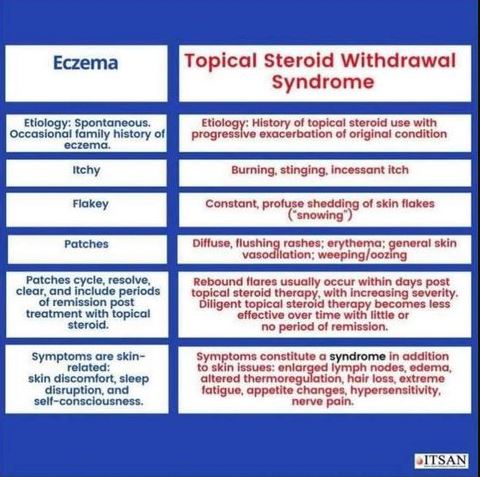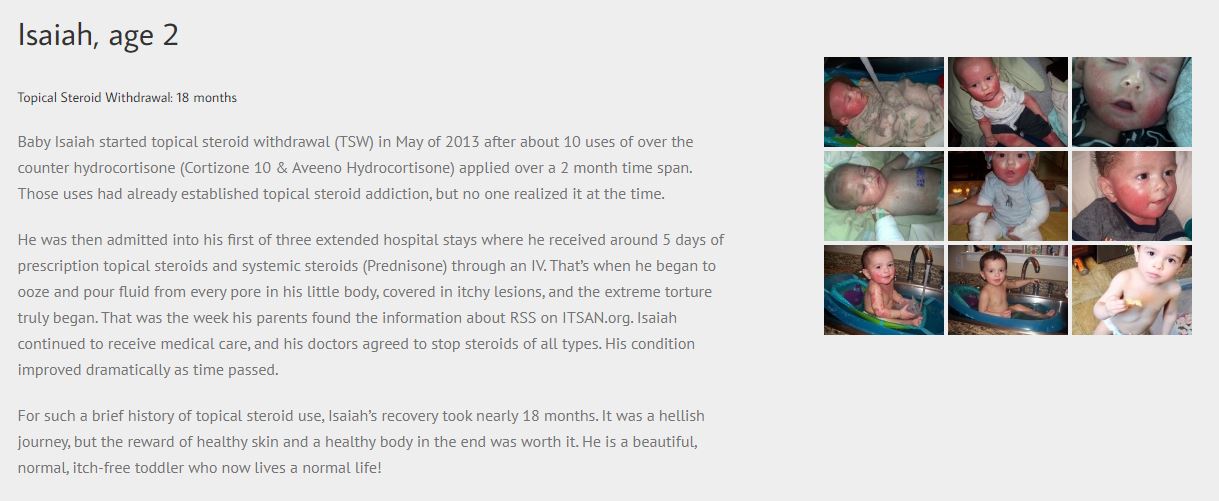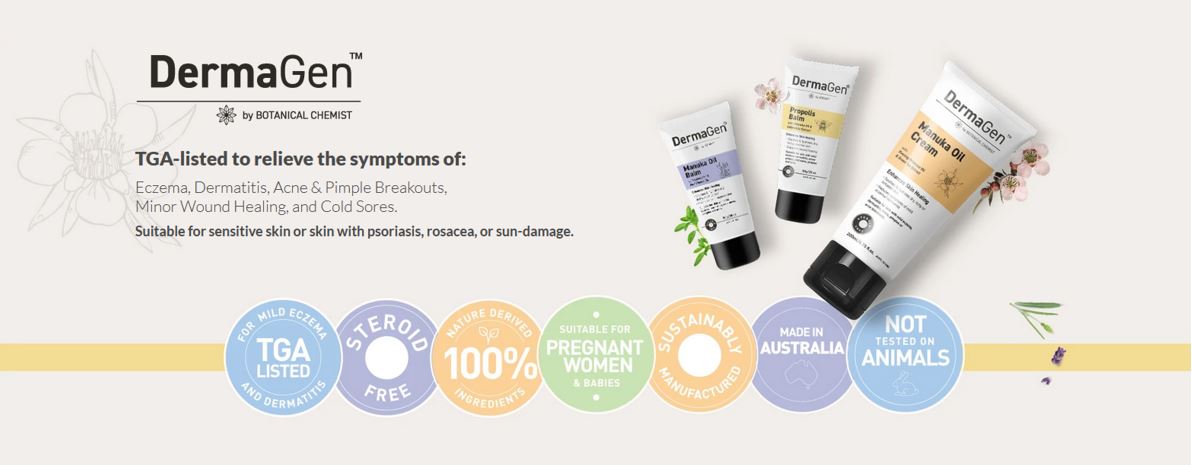What is Red Skin Syndrome?
23rd Feb 2021
Red skin syndrome, RSS, occurs as a reaction to topical steroid creams, such as hydrocortisone and similar skin creams and lotions. It is often diagnosed when the capillaries of the skin become dilated and causes the entire body to be inflamed, with red and irritated skin. However, it is important to note that not everyone’s skin will react the same, and some skin may be inflamed but not red. Topical steroids are commonly used to treat such skin conditions as psoriasis and eczema.
Symptoms of RSS often include red, burning skin, and can spread to all parts of the body. Patients with RSS may even be confined to their bed until symptoms subside.
Symptoms of RSS include rash, itching and burning. Other symptoms may include:
- swelling and fluid under the skin
- Sore eyes
- Nerve pain
- Swollen lymph nodes
- Insomnia
 |
(Please visit www.ITSAN.org for more information on RSS)
Who Gets Red Skin Syndrome?
It is a self-limiting condition, but it can
be very challenging to manage the symptoms. It can take between several months
to several years for the skin to return to normal, depending on the type of
steroid used, where it was applied and the age of the patient. Treatment
focuses on relieving the symptoms. There are no exact statistics, but a study
conducted in Japan indicated that about 12 percent of those who use topical
steroid creams may get RSS.
There is no way to know
ahead of time who will get RSS and who won't. It must be emphasized that many
people use topical steroids for many years and never have a problem. However,
there are a few factors that seem to increase the risk:
- Using strong, high-dose steroids
- Using topical steroids for longer than one year
- Using the product when it's not necessary
You're also at risk if you apply the cream to someone else on a regular basis, say for a child or dependent adult, and you don't wash it off your hands afterwards. No one is really immune to RSS, and both adults and children can contract the condition. Other risk factors include topical steroid use on the face, eye lids or genitals.
Diagnosis
RSS is often misdiagnosed because it can look like a worsening of the same condition for which the steroid cream was applied to begin with. The doctor may even raise the potency of the steroid cream, or frequency of application, making the RSS even worse. However, there is one key difference: RSS spreads to other parts of the body, even the areas where the steroid was never applied. It is unlikely, although not impossible, for a chronic skin condition like psoriasis to suddenly spread within a short period of time like RSS does.
RSS may resemble other skin conditions. To rule them out, your doctor may perform a patch test for allergies and a skin biopsy. If other tests come back negative, and you are a regular user of topical steroids, a diagnosis of RSS may be made.
Treatment
Red skin syndrome cannot be cured. It will clear on its own with time and the absence of topical steroids. Besides stopping the steroid use, your doctor may recommend colloidal oatmeal baths and oral medications containing diphenhydramine, an anti-histamine, to help sleep, or Pregabalin, a medication commonly prescribed for nerve pain, if you have symptoms such as sharp, stabbing, shooting pains. Epsom salt baths may help, too. Other remedies include acetaminophen (paracetamol) or ibuprofen for pain and jojoba oil, shea butter and zinc oxide applied to the skin to soothe it.
Manuka oil is also a popular treatment, as it has become one of the most popular essential oils available. Manuka oil contains an abundance of phytonutrients and more antioxidants than many types of tea. The essential ingredient in Manuka Oil that may help to relieve the symptoms of RSS could be the triketones, namely leptospermone, flavesone and isoleptospermone as they have anti-bacterial and soothing properties, as well as anti-oxidants which help support skin healing.
Severe symptoms may require prescription medications like antibiotics, hypnotics and drugs that suppress the immune system. Until the condition clears, use hypoallergenic skin products and switch to all-cotton clothing. This reduces further skin irritation. You can also use cotton, breathable dressings such as Tubifast or bamboo wraps such as our Bamboo Bubby clothing garments, to help prevent scratching, keeps the balms/creams on the skin and increase the absorption of the active ingredients.
Recovery time will vary, as everyone is different. Some people will see improvement in a matter of weeks. Others will need longer, perhaps even months or years.
What is the Best Skincare Range for Red Skin Syndrome?
When it comes to finding the best natural skincare products to soothe itchy, dry, inflamed skin caused by red skin syndrome or eczema, we have personally used and recommend the Dermagen by Botanical Chemist range, because the products have been specifically designed by a pharmacist, based on scientific research and including ingredients like Manuka Oil, to reduce the use of topical steroids or even avoid them altogether.

We recently spoke to Karen Cheah, the founder and pharmacist who has tirelessly developed the Dermagen range and put together the information in this blog to help us all better understand Red Skin Syndrome what she might also recommend eczema sufferers or parents of eczema sufferers can also do to help overcome or avoid the problems that Red Skin Syndrome and Topical Steroid Withdrawal presents.
She strongly recommends joining online support groups like the ITSAN Topical Steroid Withdrawal Facebook Group or others similarly available via social media to see what others are going through, and learn what they have tried that works.
Karen has also seen really good healing when patients are committed to stop the steroids, and take other supplements that focus on gut healing, collagen building (ie collagen powder, or vitamin C and Zinc, which helps wound healing and also helps collagen production). L Glutamine is great for gut healing and reducing stress, which in turn can help lessen the uncomfortable symptoms of eczema and red skin syndrome.
Most importantly to remember though is that there is no quick fix to overcoming Red Skin Syndrome and it is a process to go through, requiring patience with either yourself or your child (or both!), which we know is so difficult when its so hard to watch them suffer, but when you see before and after pictures like the ones below (or more by visiting ITSAN's page: https://www.itsan.org/tsw-images/) of patients who have healed from TSW, it's all worth it!

Photo credit: https://www.itsan.org/tsw-images/

